Understanding the Business Tools for Travel and Tourism
VerifiedAdded on 2023/01/13
|14
|5348
|20
AI Summary
This document discusses the implementation and management development of business tools for the travel and tourism industry. It covers the principles of revenue management, characteristics of travel and tourism, and the significance of income management. The document also includes a PowerPoint presentation on the HR life cycle.
Contribute Materials
Your contribution can guide someone’s learning journey. Share your
documents today.
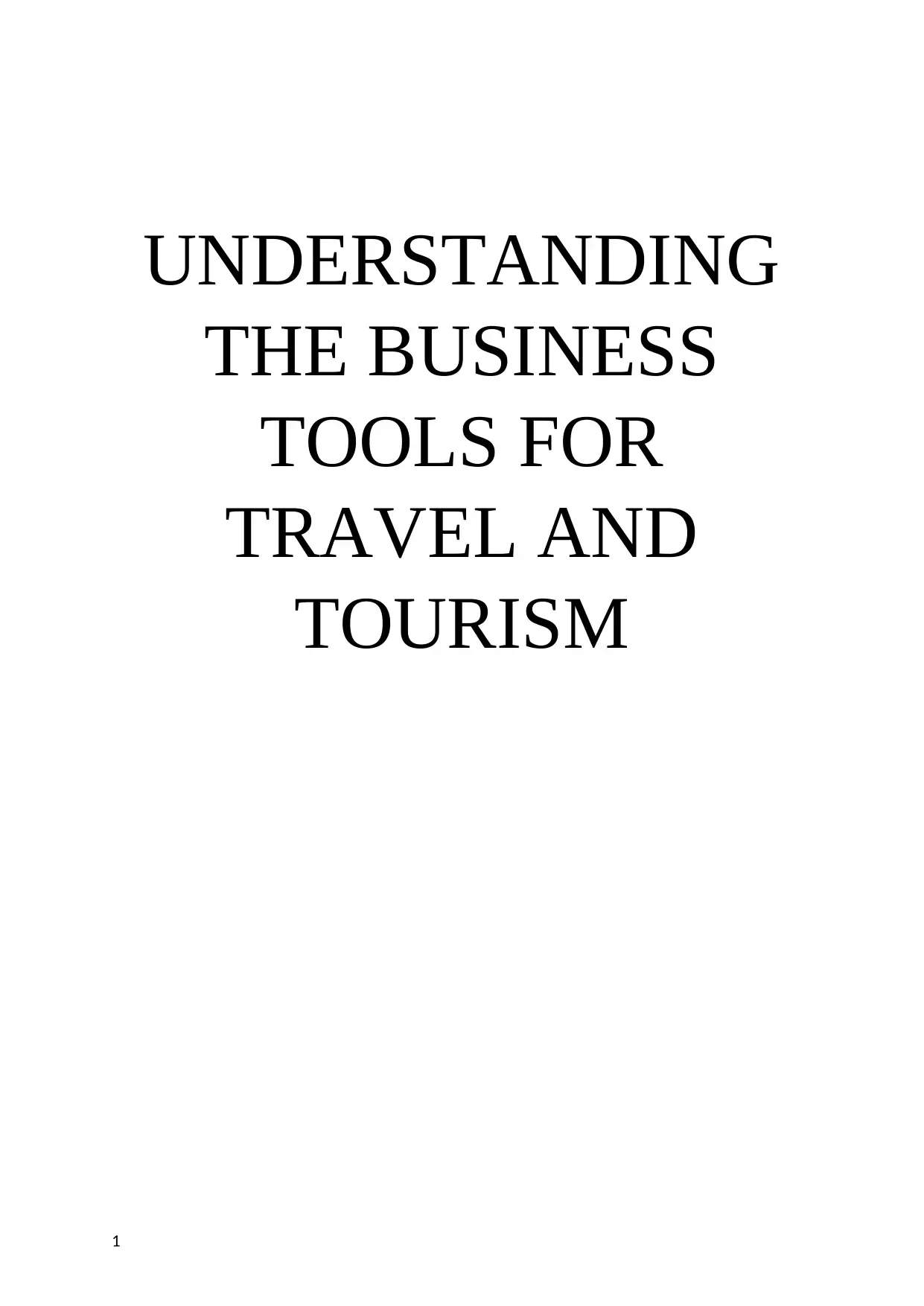
UNDERSTANDING
THE BUSINESS
TOOLS FOR
TRAVEL AND
TOURISM
1
THE BUSINESS
TOOLS FOR
TRAVEL AND
TOURISM
1
Secure Best Marks with AI Grader
Need help grading? Try our AI Grader for instant feedback on your assignments.
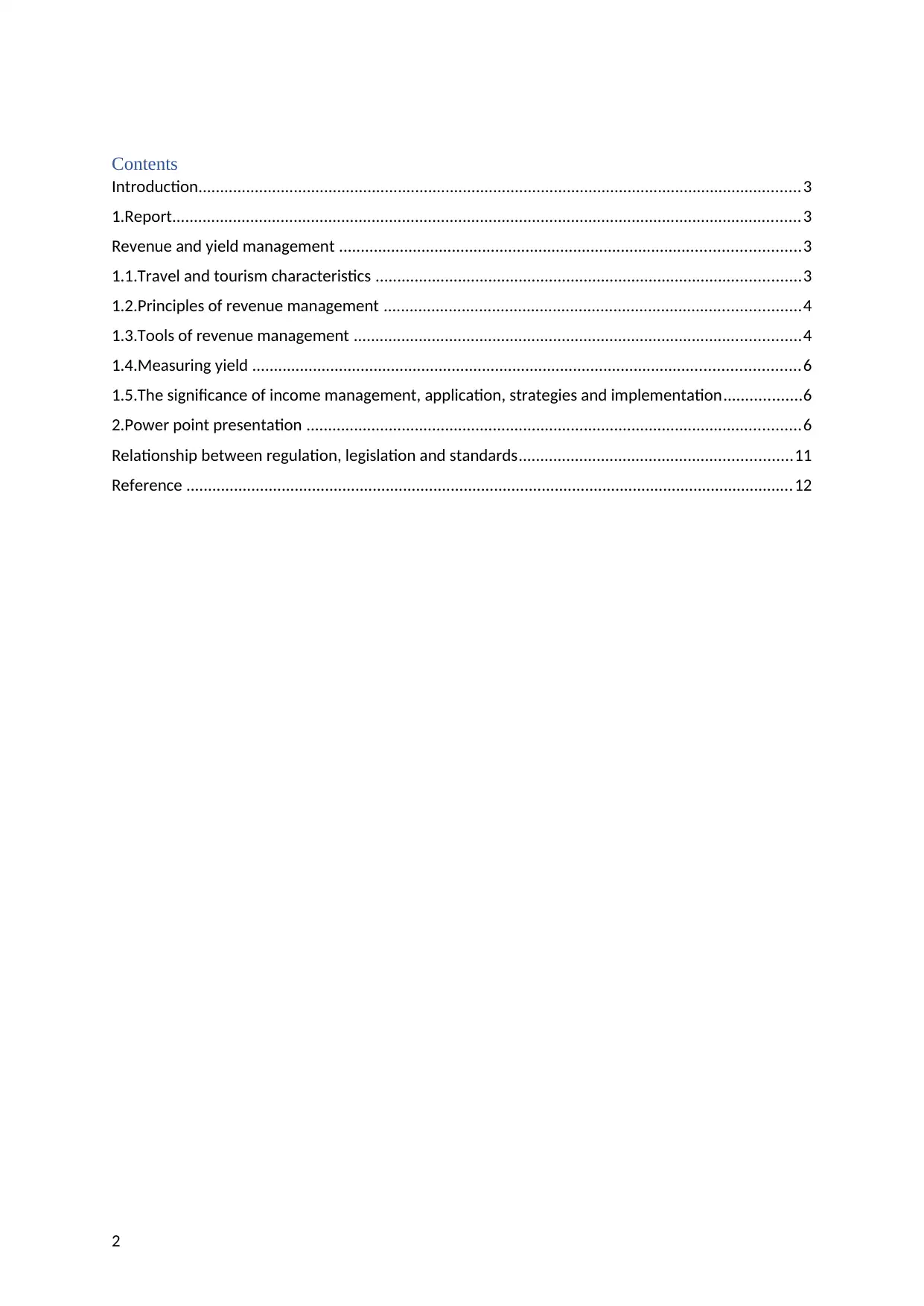
Contents
Introduction...........................................................................................................................................3
1.Report.................................................................................................................................................3
Revenue and yield management ..........................................................................................................3
1.1.Travel and tourism characteristics ..................................................................................................3
1.2.Principles of revenue management ................................................................................................4
1.3.Tools of revenue management .......................................................................................................4
1.4.Measuring yield ..............................................................................................................................6
1.5.The significance of income management, application, strategies and implementation..................6
2.Power point presentation ..................................................................................................................6
Relationship between regulation, legislation and standards...............................................................11
Reference ............................................................................................................................................12
2
Introduction...........................................................................................................................................3
1.Report.................................................................................................................................................3
Revenue and yield management ..........................................................................................................3
1.1.Travel and tourism characteristics ..................................................................................................3
1.2.Principles of revenue management ................................................................................................4
1.3.Tools of revenue management .......................................................................................................4
1.4.Measuring yield ..............................................................................................................................6
1.5.The significance of income management, application, strategies and implementation..................6
2.Power point presentation ..................................................................................................................6
Relationship between regulation, legislation and standards...............................................................11
Reference ............................................................................................................................................12
2

Introduction
The aim of this document is to examine and talk about the strategy’s implementation and
management development.
Understanding the industry that you work in and how different aspects of the same are
interconnected with each other, the actions that a manager in an organisation will have an
influence on all functional departments of the company.
Thus, every organization has her own specific requirements regarding the talents, attitudes,
responsibilities and competences that an HRM must gain/have so as to grasp how the climate
of the business and major principles of revenue management, retention of employees,
recruitment, effective communication and addressing the different rules,legislation as well as
regulation.
Human resources management is an important function of any organization. It encompasses
the administration of people in corporations from a large-scale perspective i.e. managing
individuals in the form of a cooperative relationships between organization and personnel.
1. Report
Yield and Revenue management
“Yield management is the application of
information systems and pricing strategies
to allocate the right capacity to the right
customer at the right place at the right time
through the right channels” (Bodily, 1992)
(Kimes, 1995)
“Revenue management is the process of
optimising the overall revenue by carefully
manipulating the price through discount
allocation to different target groups of
customers offering a range of products and
services under different demand conditions
during the trading cycle which may extent
up to one calendar year”.
Both revenue as well as yield management
help organisations in making effective
decisions that are beneficial for
organisations. They should be used in
conjuction to each other as they both deal
with different things.
Yield management is used by corporation
in effective way and has some specific
characteristics like a relative fixed
capacity, demand that can be predicted,
inventory, an accurate structure of the cost
and price as well as demand that can vary
and is uncertain.
Airlines in general use yield management
to improve their products and services and
forecasting the demand and also seen as a
managing tool in the airline industry with a
vast capability to increase the pecuniary
functioning of the air company.
3
The aim of this document is to examine and talk about the strategy’s implementation and
management development.
Understanding the industry that you work in and how different aspects of the same are
interconnected with each other, the actions that a manager in an organisation will have an
influence on all functional departments of the company.
Thus, every organization has her own specific requirements regarding the talents, attitudes,
responsibilities and competences that an HRM must gain/have so as to grasp how the climate
of the business and major principles of revenue management, retention of employees,
recruitment, effective communication and addressing the different rules,legislation as well as
regulation.
Human resources management is an important function of any organization. It encompasses
the administration of people in corporations from a large-scale perspective i.e. managing
individuals in the form of a cooperative relationships between organization and personnel.
1. Report
Yield and Revenue management
“Yield management is the application of
information systems and pricing strategies
to allocate the right capacity to the right
customer at the right place at the right time
through the right channels” (Bodily, 1992)
(Kimes, 1995)
“Revenue management is the process of
optimising the overall revenue by carefully
manipulating the price through discount
allocation to different target groups of
customers offering a range of products and
services under different demand conditions
during the trading cycle which may extent
up to one calendar year”.
Both revenue as well as yield management
help organisations in making effective
decisions that are beneficial for
organisations. They should be used in
conjuction to each other as they both deal
with different things.
Yield management is used by corporation
in effective way and has some specific
characteristics like a relative fixed
capacity, demand that can be predicted,
inventory, an accurate structure of the cost
and price as well as demand that can vary
and is uncertain.
Airlines in general use yield management
to improve their products and services and
forecasting the demand and also seen as a
managing tool in the airline industry with a
vast capability to increase the pecuniary
functioning of the air company.
3
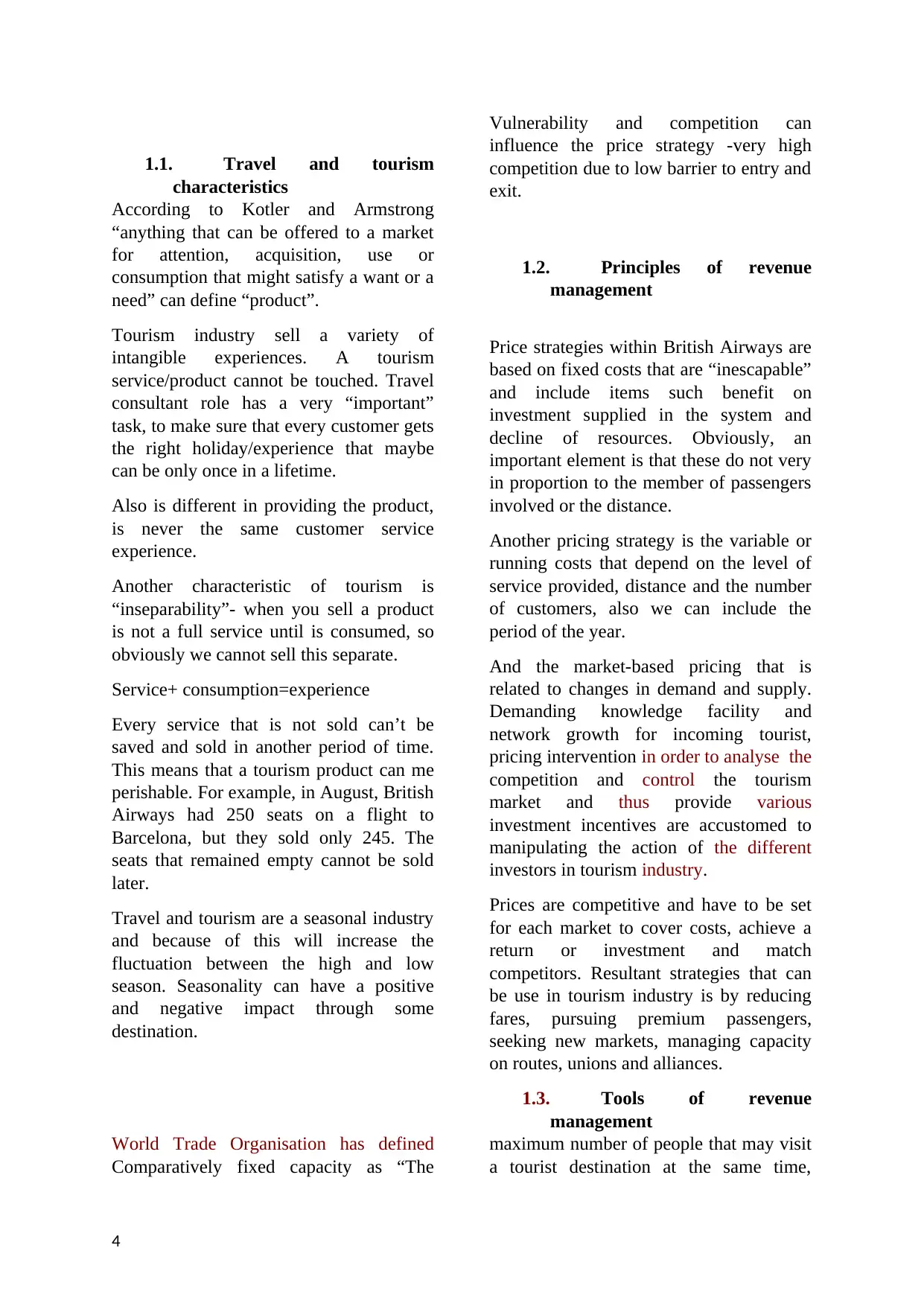
1.1. Travel and tourism
characteristics
According to Kotler and Armstrong
“anything that can be offered to a market
for attention, acquisition, use or
consumption that might satisfy a want or a
need” can define “product”.
Tourism industry sell a variety of
intangible experiences. A tourism
service/product cannot be touched. Travel
consultant role has a very “important”
task, to make sure that every customer gets
the right holiday/experience that maybe
can be only once in a lifetime.
Also is different in providing the product,
is never the same customer service
experience.
Another characteristic of tourism is
“inseparability”- when you sell a product
is not a full service until is consumed, so
obviously we cannot sell this separate.
Service+ consumption=experience
Every service that is not sold can’t be
saved and sold in another period of time.
This means that a tourism product can me
perishable. For example, in August, British
Airways had 250 seats on a flight to
Barcelona, but they sold only 245. The
seats that remained empty cannot be sold
later.
Travel and tourism are a seasonal industry
and because of this will increase the
fluctuation between the high and low
season. Seasonality can have a positive
and negative impact through some
destination.
Vulnerability and competition can
influence the price strategy -very high
competition due to low barrier to entry and
exit.
1.2. Principles of revenue
management
Price strategies within British Airways are
based on fixed costs that are “inescapable”
and include items such benefit on
investment supplied in the system and
decline of resources. Obviously, an
important element is that these do not very
in proportion to the member of passengers
involved or the distance.
Another pricing strategy is the variable or
running costs that depend on the level of
service provided, distance and the number
of customers, also we can include the
period of the year.
And the market-based pricing that is
related to changes in demand and supply.
Demanding knowledge facility and
network growth for incoming tourist,
pricing intervention in order to analyse the
competition and control the tourism
market and thus provide various
investment incentives are accustomed to
manipulating the action of the different
investors in tourism industry.
Prices are competitive and have to be set
for each market to cover costs, achieve a
return or investment and match
competitors. Resultant strategies that can
be use in tourism industry is by reducing
fares, pursuing premium passengers,
seeking new markets, managing capacity
on routes, unions and alliances.
1.3. Tools of revenue
management
World Trade Organisation has defined
Comparatively fixed capacity as “The
maximum number of people that may visit
a tourist destination at the same time,
4
characteristics
According to Kotler and Armstrong
“anything that can be offered to a market
for attention, acquisition, use or
consumption that might satisfy a want or a
need” can define “product”.
Tourism industry sell a variety of
intangible experiences. A tourism
service/product cannot be touched. Travel
consultant role has a very “important”
task, to make sure that every customer gets
the right holiday/experience that maybe
can be only once in a lifetime.
Also is different in providing the product,
is never the same customer service
experience.
Another characteristic of tourism is
“inseparability”- when you sell a product
is not a full service until is consumed, so
obviously we cannot sell this separate.
Service+ consumption=experience
Every service that is not sold can’t be
saved and sold in another period of time.
This means that a tourism product can me
perishable. For example, in August, British
Airways had 250 seats on a flight to
Barcelona, but they sold only 245. The
seats that remained empty cannot be sold
later.
Travel and tourism are a seasonal industry
and because of this will increase the
fluctuation between the high and low
season. Seasonality can have a positive
and negative impact through some
destination.
Vulnerability and competition can
influence the price strategy -very high
competition due to low barrier to entry and
exit.
1.2. Principles of revenue
management
Price strategies within British Airways are
based on fixed costs that are “inescapable”
and include items such benefit on
investment supplied in the system and
decline of resources. Obviously, an
important element is that these do not very
in proportion to the member of passengers
involved or the distance.
Another pricing strategy is the variable or
running costs that depend on the level of
service provided, distance and the number
of customers, also we can include the
period of the year.
And the market-based pricing that is
related to changes in demand and supply.
Demanding knowledge facility and
network growth for incoming tourist,
pricing intervention in order to analyse the
competition and control the tourism
market and thus provide various
investment incentives are accustomed to
manipulating the action of the different
investors in tourism industry.
Prices are competitive and have to be set
for each market to cover costs, achieve a
return or investment and match
competitors. Resultant strategies that can
be use in tourism industry is by reducing
fares, pursuing premium passengers,
seeking new markets, managing capacity
on routes, unions and alliances.
1.3. Tools of revenue
management
World Trade Organisation has defined
Comparatively fixed capacity as “The
maximum number of people that may visit
a tourist destination at the same time,
4
Secure Best Marks with AI Grader
Need help grading? Try our AI Grader for instant feedback on your assignments.
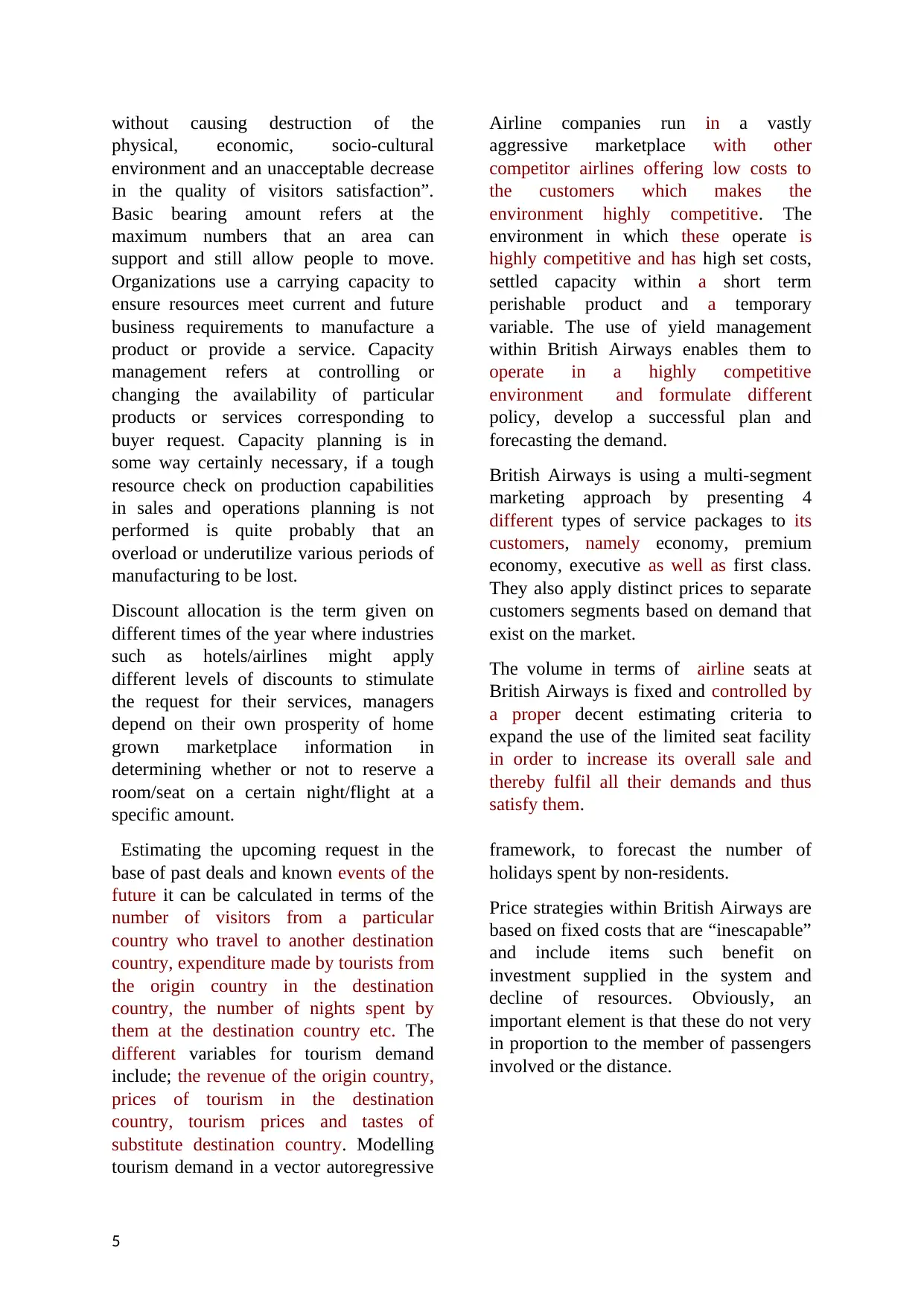
without causing destruction of the
physical, economic, socio-cultural
environment and an unacceptable decrease
in the quality of visitors satisfaction”.
Basic bearing amount refers at the
maximum numbers that an area can
support and still allow people to move.
Organizations use a carrying capacity to
ensure resources meet current and future
business requirements to manufacture a
product or provide a service. Capacity
management refers at controlling or
changing the availability of particular
products or services corresponding to
buyer request. Capacity planning is in
some way certainly necessary, if a tough
resource check on production capabilities
in sales and operations planning is not
performed is quite probably that an
overload or underutilize various periods of
manufacturing to be lost.
Discount allocation is the term given on
different times of the year where industries
such as hotels/airlines might apply
different levels of discounts to stimulate
the request for their services, managers
depend on their own prosperity of home
grown marketplace information in
determining whether or not to reserve a
room/seat on a certain night/flight at a
specific amount.
Airline companies run in a vastly
aggressive marketplace with other
competitor airlines offering low costs to
the customers which makes the
environment highly competitive. The
environment in which these operate is
highly competitive and has high set costs,
settled capacity within a short term
perishable product and a temporary
variable. The use of yield management
within British Airways enables them to
operate in a highly competitive
environment and formulate different
policy, develop a successful plan and
forecasting the demand.
British Airways is using a multi-segment
marketing approach by presenting 4
different types of service packages to its
customers, namely economy, premium
economy, executive as well as first class.
They also apply distinct prices to separate
customers segments based on demand that
exist on the market.
The volume in terms of airline seats at
British Airways is fixed and controlled by
a proper decent estimating criteria to
expand the use of the limited seat facility
in order to increase its overall sale and
thereby fulfil all their demands and thus
satisfy them.
Estimating the upcoming request in the
base of past deals and known events of the
future it can be calculated in terms of the
number of visitors from a particular
country who travel to another destination
country, expenditure made by tourists from
the origin country in the destination
country, the number of nights spent by
them at the destination country etc. The
different variables for tourism demand
include; the revenue of the origin country,
prices of tourism in the destination
country, tourism prices and tastes of
substitute destination country. Modelling
tourism demand in a vector autoregressive
framework, to forecast the number of
holidays spent by non-residents.
Price strategies within British Airways are
based on fixed costs that are “inescapable”
and include items such benefit on
investment supplied in the system and
decline of resources. Obviously, an
important element is that these do not very
in proportion to the member of passengers
involved or the distance.
5
physical, economic, socio-cultural
environment and an unacceptable decrease
in the quality of visitors satisfaction”.
Basic bearing amount refers at the
maximum numbers that an area can
support and still allow people to move.
Organizations use a carrying capacity to
ensure resources meet current and future
business requirements to manufacture a
product or provide a service. Capacity
management refers at controlling or
changing the availability of particular
products or services corresponding to
buyer request. Capacity planning is in
some way certainly necessary, if a tough
resource check on production capabilities
in sales and operations planning is not
performed is quite probably that an
overload or underutilize various periods of
manufacturing to be lost.
Discount allocation is the term given on
different times of the year where industries
such as hotels/airlines might apply
different levels of discounts to stimulate
the request for their services, managers
depend on their own prosperity of home
grown marketplace information in
determining whether or not to reserve a
room/seat on a certain night/flight at a
specific amount.
Airline companies run in a vastly
aggressive marketplace with other
competitor airlines offering low costs to
the customers which makes the
environment highly competitive. The
environment in which these operate is
highly competitive and has high set costs,
settled capacity within a short term
perishable product and a temporary
variable. The use of yield management
within British Airways enables them to
operate in a highly competitive
environment and formulate different
policy, develop a successful plan and
forecasting the demand.
British Airways is using a multi-segment
marketing approach by presenting 4
different types of service packages to its
customers, namely economy, premium
economy, executive as well as first class.
They also apply distinct prices to separate
customers segments based on demand that
exist on the market.
The volume in terms of airline seats at
British Airways is fixed and controlled by
a proper decent estimating criteria to
expand the use of the limited seat facility
in order to increase its overall sale and
thereby fulfil all their demands and thus
satisfy them.
Estimating the upcoming request in the
base of past deals and known events of the
future it can be calculated in terms of the
number of visitors from a particular
country who travel to another destination
country, expenditure made by tourists from
the origin country in the destination
country, the number of nights spent by
them at the destination country etc. The
different variables for tourism demand
include; the revenue of the origin country,
prices of tourism in the destination
country, tourism prices and tastes of
substitute destination country. Modelling
tourism demand in a vector autoregressive
framework, to forecast the number of
holidays spent by non-residents.
Price strategies within British Airways are
based on fixed costs that are “inescapable”
and include items such benefit on
investment supplied in the system and
decline of resources. Obviously, an
important element is that these do not very
in proportion to the member of passengers
involved or the distance.
5
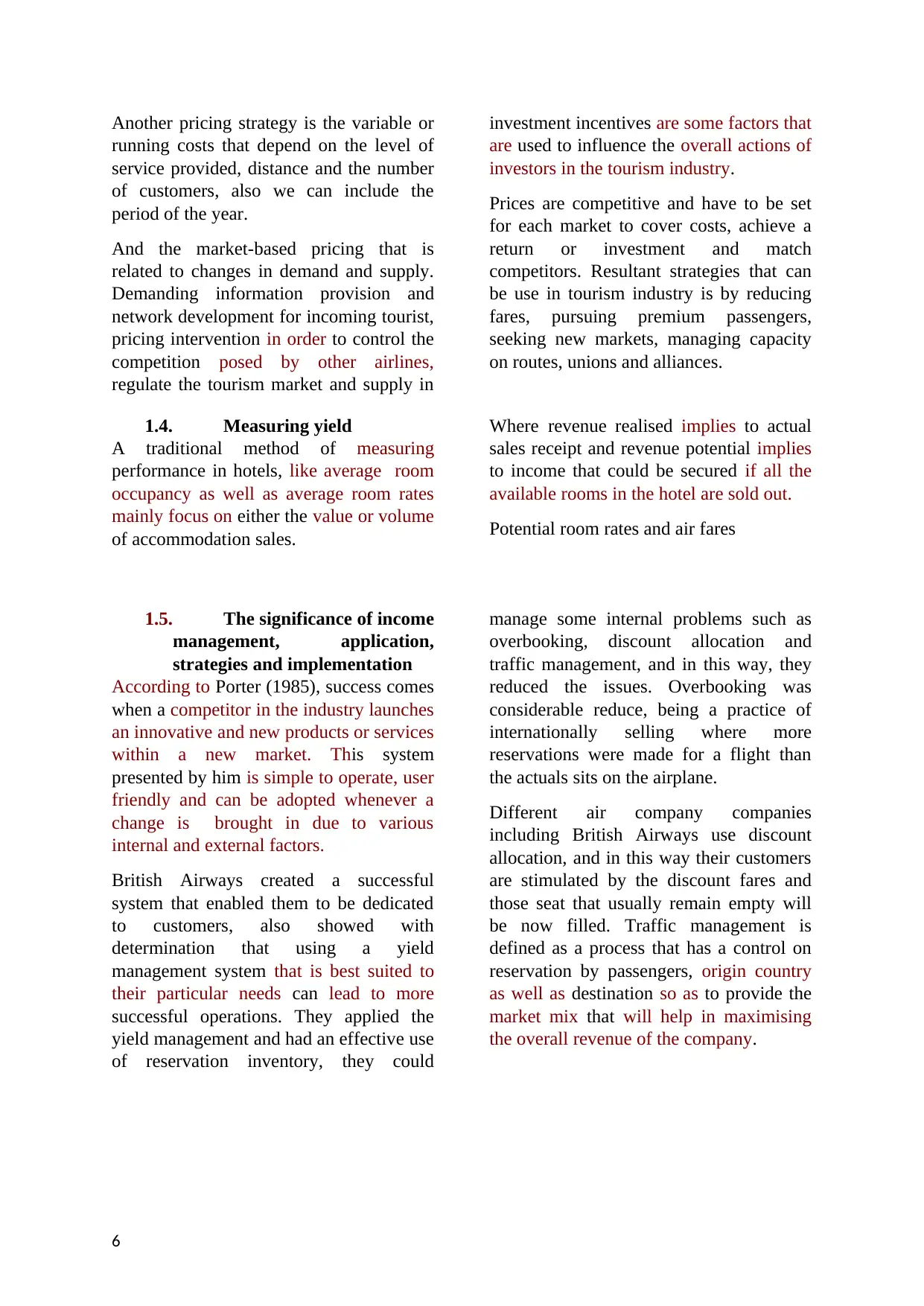
Another pricing strategy is the variable or
running costs that depend on the level of
service provided, distance and the number
of customers, also we can include the
period of the year.
And the market-based pricing that is
related to changes in demand and supply.
Demanding information provision and
network development for incoming tourist,
pricing intervention in order to control the
competition posed by other airlines,
regulate the tourism market and supply in
investment incentives are some factors that
are used to influence the overall actions of
investors in the tourism industry.
Prices are competitive and have to be set
for each market to cover costs, achieve a
return or investment and match
competitors. Resultant strategies that can
be use in tourism industry is by reducing
fares, pursuing premium passengers,
seeking new markets, managing capacity
on routes, unions and alliances.
1.4. Measuring yield
A traditional method of measuring
performance in hotels, like average room
occupancy as well as average room rates
mainly focus on either the value or volume
of accommodation sales.
Where revenue realised implies to actual
sales receipt and revenue potential implies
to income that could be secured if all the
available rooms in the hotel are sold out.
Potential room rates and air fares
1.5. The significance of income
management, application,
strategies and implementation
According to Porter (1985), success comes
when a competitor in the industry launches
an innovative and new products or services
within a new market. This system
presented by him is simple to operate, user
friendly and can be adopted whenever a
change is brought in due to various
internal and external factors.
British Airways created a successful
system that enabled them to be dedicated
to customers, also showed with
determination that using a yield
management system that is best suited to
their particular needs can lead to more
successful operations. They applied the
yield management and had an effective use
of reservation inventory, they could
manage some internal problems such as
overbooking, discount allocation and
traffic management, and in this way, they
reduced the issues. Overbooking was
considerable reduce, being a practice of
internationally selling where more
reservations were made for a flight than
the actuals sits on the airplane.
Different air company companies
including British Airways use discount
allocation, and in this way their customers
are stimulated by the discount fares and
those seat that usually remain empty will
be now filled. Traffic management is
defined as a process that has a control on
reservation by passengers, origin country
as well as destination so as to provide the
market mix that will help in maximising
the overall revenue of the company.
6
running costs that depend on the level of
service provided, distance and the number
of customers, also we can include the
period of the year.
And the market-based pricing that is
related to changes in demand and supply.
Demanding information provision and
network development for incoming tourist,
pricing intervention in order to control the
competition posed by other airlines,
regulate the tourism market and supply in
investment incentives are some factors that
are used to influence the overall actions of
investors in the tourism industry.
Prices are competitive and have to be set
for each market to cover costs, achieve a
return or investment and match
competitors. Resultant strategies that can
be use in tourism industry is by reducing
fares, pursuing premium passengers,
seeking new markets, managing capacity
on routes, unions and alliances.
1.4. Measuring yield
A traditional method of measuring
performance in hotels, like average room
occupancy as well as average room rates
mainly focus on either the value or volume
of accommodation sales.
Where revenue realised implies to actual
sales receipt and revenue potential implies
to income that could be secured if all the
available rooms in the hotel are sold out.
Potential room rates and air fares
1.5. The significance of income
management, application,
strategies and implementation
According to Porter (1985), success comes
when a competitor in the industry launches
an innovative and new products or services
within a new market. This system
presented by him is simple to operate, user
friendly and can be adopted whenever a
change is brought in due to various
internal and external factors.
British Airways created a successful
system that enabled them to be dedicated
to customers, also showed with
determination that using a yield
management system that is best suited to
their particular needs can lead to more
successful operations. They applied the
yield management and had an effective use
of reservation inventory, they could
manage some internal problems such as
overbooking, discount allocation and
traffic management, and in this way, they
reduced the issues. Overbooking was
considerable reduce, being a practice of
internationally selling where more
reservations were made for a flight than
the actuals sits on the airplane.
Different air company companies
including British Airways use discount
allocation, and in this way their customers
are stimulated by the discount fares and
those seat that usually remain empty will
be now filled. Traffic management is
defined as a process that has a control on
reservation by passengers, origin country
as well as destination so as to provide the
market mix that will help in maximising
the overall revenue of the company.
6
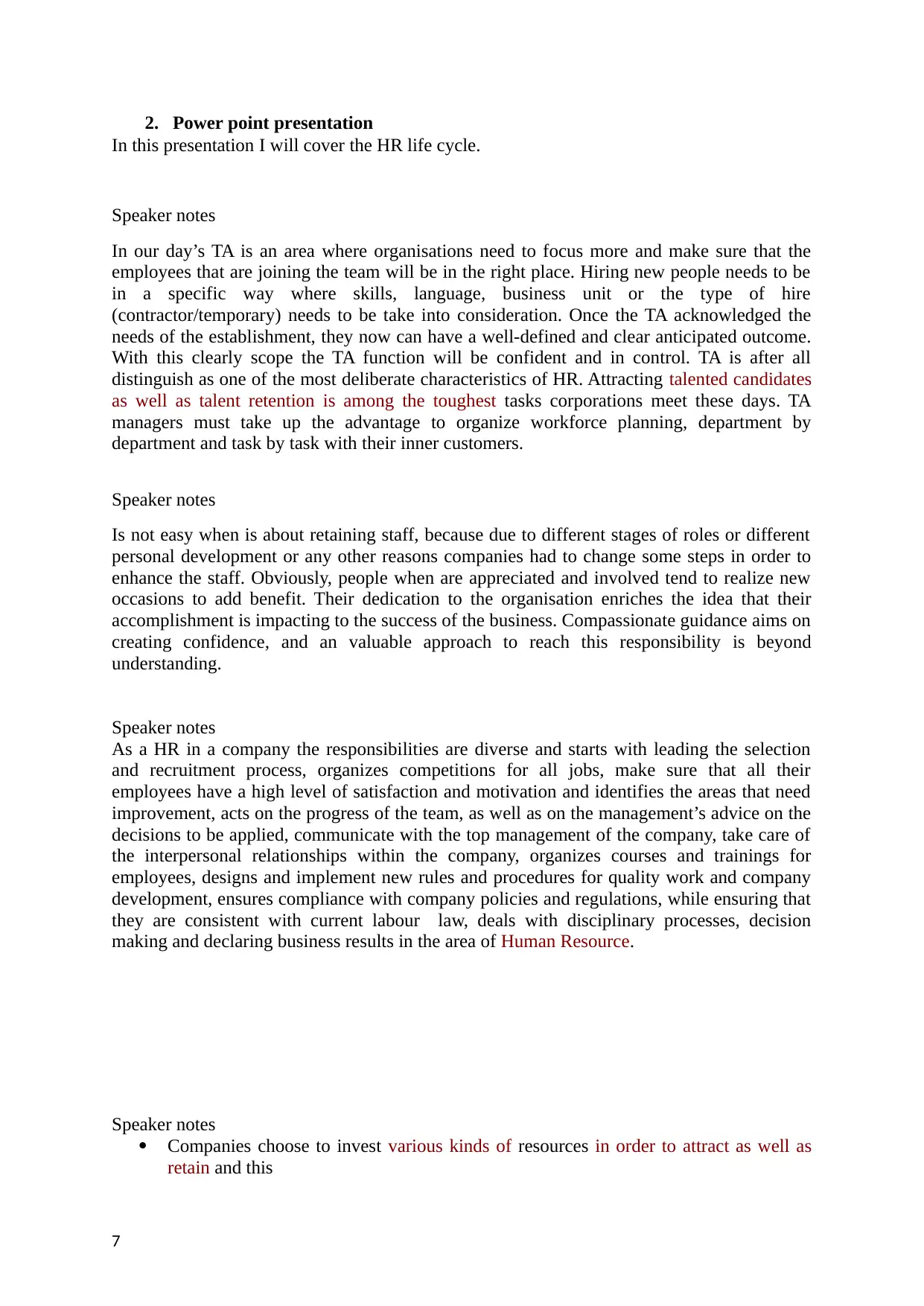
2. Power point presentation
In this presentation I will cover the HR life cycle.
Speaker notes
In our day’s TA is an area where organisations need to focus more and make sure that the
employees that are joining the team will be in the right place. Hiring new people needs to be
in a specific way where skills, language, business unit or the type of hire
(contractor/temporary) needs to be take into consideration. Once the TA acknowledged the
needs of the establishment, they now can have a well-defined and clear anticipated outcome.
With this clearly scope the TA function will be confident and in control. TA is after all
distinguish as one of the most deliberate characteristics of HR. Attracting talented candidates
as well as talent retention is among the toughest tasks corporations meet these days. TA
managers must take up the advantage to organize workforce planning, department by
department and task by task with their inner customers.
Speaker notes
Is not easy when is about retaining staff, because due to different stages of roles or different
personal development or any other reasons companies had to change some steps in order to
enhance the staff. Obviously, people when are appreciated and involved tend to realize new
occasions to add benefit. Their dedication to the organisation enriches the idea that their
accomplishment is impacting to the success of the business. Compassionate guidance aims on
creating confidence, and an valuable approach to reach this responsibility is beyond
understanding.
Speaker notes
As a HR in a company the responsibilities are diverse and starts with leading the selection
and recruitment process, organizes competitions for all jobs, make sure that all their
employees have a high level of satisfaction and motivation and identifies the areas that need
improvement, acts on the progress of the team, as well as on the management’s advice on the
decisions to be applied, communicate with the top management of the company, take care of
the interpersonal relationships within the company, organizes courses and trainings for
employees, designs and implement new rules and procedures for quality work and company
development, ensures compliance with company policies and regulations, while ensuring that
they are consistent with current labour law, deals with disciplinary processes, decision
making and declaring business results in the area of Human Resource.
Speaker notes
Companies choose to invest various kinds of resources in order to attract as well as
retain and this
7
In this presentation I will cover the HR life cycle.
Speaker notes
In our day’s TA is an area where organisations need to focus more and make sure that the
employees that are joining the team will be in the right place. Hiring new people needs to be
in a specific way where skills, language, business unit or the type of hire
(contractor/temporary) needs to be take into consideration. Once the TA acknowledged the
needs of the establishment, they now can have a well-defined and clear anticipated outcome.
With this clearly scope the TA function will be confident and in control. TA is after all
distinguish as one of the most deliberate characteristics of HR. Attracting talented candidates
as well as talent retention is among the toughest tasks corporations meet these days. TA
managers must take up the advantage to organize workforce planning, department by
department and task by task with their inner customers.
Speaker notes
Is not easy when is about retaining staff, because due to different stages of roles or different
personal development or any other reasons companies had to change some steps in order to
enhance the staff. Obviously, people when are appreciated and involved tend to realize new
occasions to add benefit. Their dedication to the organisation enriches the idea that their
accomplishment is impacting to the success of the business. Compassionate guidance aims on
creating confidence, and an valuable approach to reach this responsibility is beyond
understanding.
Speaker notes
As a HR in a company the responsibilities are diverse and starts with leading the selection
and recruitment process, organizes competitions for all jobs, make sure that all their
employees have a high level of satisfaction and motivation and identifies the areas that need
improvement, acts on the progress of the team, as well as on the management’s advice on the
decisions to be applied, communicate with the top management of the company, take care of
the interpersonal relationships within the company, organizes courses and trainings for
employees, designs and implement new rules and procedures for quality work and company
development, ensures compliance with company policies and regulations, while ensuring that
they are consistent with current labour law, deals with disciplinary processes, decision
making and declaring business results in the area of Human Resource.
Speaker notes
Companies choose to invest various kinds of resources in order to attract as well as
retain and this
7
Paraphrase This Document
Need a fresh take? Get an instant paraphrase of this document with our AI Paraphraser
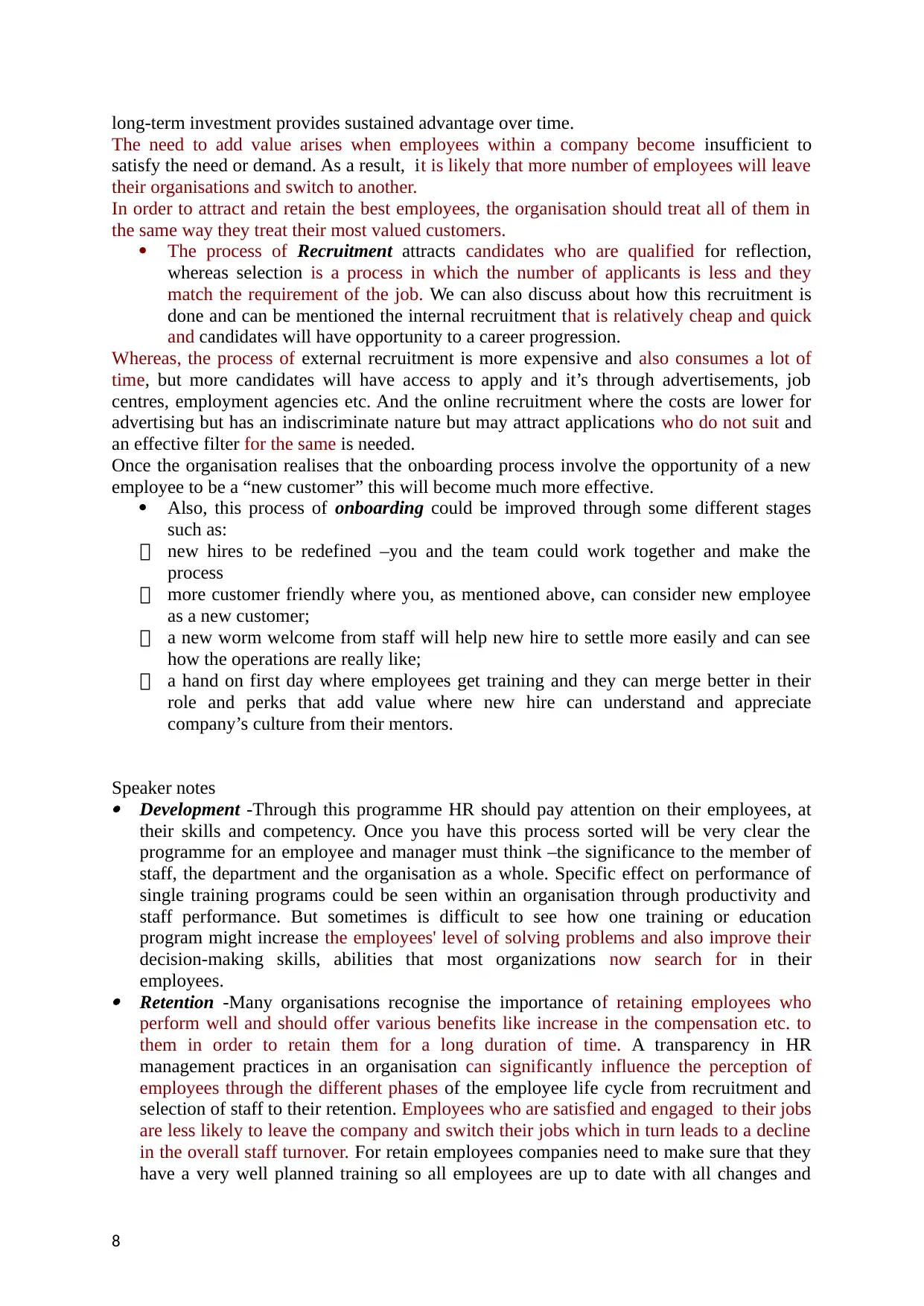
long-term investment provides sustained advantage over time.
The need to add value arises when employees within a company become insufficient to
satisfy the need or demand. As a result, it is likely that more number of employees will leave
their organisations and switch to another.
In order to attract and retain the best employees, the organisation should treat all of them in
the same way they treat their most valued customers.
The process of Recruitment attracts candidates who are qualified for reflection,
whereas selection is a process in which the number of applicants is less and they
match the requirement of the job. We can also discuss about how this recruitment is
done and can be mentioned the internal recruitment that is relatively cheap and quick
and candidates will have opportunity to a career progression.
Whereas, the process of external recruitment is more expensive and also consumes a lot of
time, but more candidates will have access to apply and it’s through advertisements, job
centres, employment agencies etc. And the online recruitment where the costs are lower for
advertising but has an indiscriminate nature but may attract applications who do not suit and
an effective filter for the same is needed.
Once the organisation realises that the onboarding process involve the opportunity of a new
employee to be a “new customer” this will become much more effective.
Also, this process of onboarding could be improved through some different stages
such as:
new hires to be redefined –you and the team could work together and make the
process
more customer friendly where you, as mentioned above, can consider new employee
as a new customer;
a new worm welcome from staff will help new hire to settle more easily and can see
how the operations are really like;
a hand on first day where employees get training and they can merge better in their
role and perks that add value where new hire can understand and appreciate
company’s culture from their mentors.
Speaker notes Development -Through this programme HR should pay attention on their employees, at
their skills and competency. Once you have this process sorted will be very clear the
programme for an employee and manager must think –the significance to the member of
staff, the department and the organisation as a whole. Specific effect on performance of
single training programs could be seen within an organisation through productivity and
staff performance. But sometimes is difficult to see how one training or education
program might increase the employees' level of solving problems and also improve their
decision-making skills, abilities that most organizations now search for in their
employees. Retention -Many organisations recognise the importance of retaining employees who
perform well and should offer various benefits like increase in the compensation etc. to
them in order to retain them for a long duration of time. A transparency in HR
management practices in an organisation can significantly influence the perception of
employees through the different phases of the employee life cycle from recruitment and
selection of staff to their retention. Employees who are satisfied and engaged to their jobs
are less likely to leave the company and switch their jobs which in turn leads to a decline
in the overall staff turnover. For retain employees companies need to make sure that they
have a very well planned training so all employees are up to date with all changes and
8
The need to add value arises when employees within a company become insufficient to
satisfy the need or demand. As a result, it is likely that more number of employees will leave
their organisations and switch to another.
In order to attract and retain the best employees, the organisation should treat all of them in
the same way they treat their most valued customers.
The process of Recruitment attracts candidates who are qualified for reflection,
whereas selection is a process in which the number of applicants is less and they
match the requirement of the job. We can also discuss about how this recruitment is
done and can be mentioned the internal recruitment that is relatively cheap and quick
and candidates will have opportunity to a career progression.
Whereas, the process of external recruitment is more expensive and also consumes a lot of
time, but more candidates will have access to apply and it’s through advertisements, job
centres, employment agencies etc. And the online recruitment where the costs are lower for
advertising but has an indiscriminate nature but may attract applications who do not suit and
an effective filter for the same is needed.
Once the organisation realises that the onboarding process involve the opportunity of a new
employee to be a “new customer” this will become much more effective.
Also, this process of onboarding could be improved through some different stages
such as:
new hires to be redefined –you and the team could work together and make the
process
more customer friendly where you, as mentioned above, can consider new employee
as a new customer;
a new worm welcome from staff will help new hire to settle more easily and can see
how the operations are really like;
a hand on first day where employees get training and they can merge better in their
role and perks that add value where new hire can understand and appreciate
company’s culture from their mentors.
Speaker notes Development -Through this programme HR should pay attention on their employees, at
their skills and competency. Once you have this process sorted will be very clear the
programme for an employee and manager must think –the significance to the member of
staff, the department and the organisation as a whole. Specific effect on performance of
single training programs could be seen within an organisation through productivity and
staff performance. But sometimes is difficult to see how one training or education
program might increase the employees' level of solving problems and also improve their
decision-making skills, abilities that most organizations now search for in their
employees. Retention -Many organisations recognise the importance of retaining employees who
perform well and should offer various benefits like increase in the compensation etc. to
them in order to retain them for a long duration of time. A transparency in HR
management practices in an organisation can significantly influence the perception of
employees through the different phases of the employee life cycle from recruitment and
selection of staff to their retention. Employees who are satisfied and engaged to their jobs
are less likely to leave the company and switch their jobs which in turn leads to a decline
in the overall staff turnover. For retain employees companies need to make sure that they
have a very well planned training so all employees are up to date with all changes and
8

requirement within the company also time to time offer rewards in different ways, also
show employees recognition, while motivated and happy they will continue to do a better
and efficient work.
Separation -A sensitive issue for any organization. This separation can be in a voluntary
when the employee decides to quit a certain job having different reasons (professional
reasons/ personal reasons) or involuntary (health problems, behavioural problems or
organizational problems).
Speaker notes
Internal recruitment - they post the job and all employees who are interested will
definitely apply for the job, or management also can offer the job to a specific employee.
External recruitment – they use as much as external methods they can, in this way more
people are aware about the role. Methods they use are agencies, social media (this method
has a huge impact) company’s website, newspapers, etc. As an interview method they
can do it by telephone, video or face to face.
Speaker notes
A complex process of planning can reach the objectives and standards that need to be
achieved by the individuals in a specific area.
The action task is when they implement development plan and are guided and support by
their manager.
Individuals and sometimes managers will monitor the actions and outcomes and provide a
continuous feedback. In review stage they are performance assist in any time of the year and
checked back with an informal feedback. (Armstrong, 2016)
Speaker notes
The competence of both managers as well as employees is critical to the achievement of
business objectives and organisational competitiveness, also they should work with
coordination and in the same direction as well as share the same vision in order to achieve
the goals and objectives of the company. Also, must be proactive and responsive to use
human resources effectively and efficiently and maximise productivity.
Through employee development, the skills and talent of the employees can be used in a more
effective and efficient manner. Also, more competent employees are more likely to gain
management recognition, increasing job satisfaction and motivation. Training and
development opportunities can be provided to them through various individual methods like
training courses, mentoring, coaching, computer interactive learning, planned experiences,
self-managed learning or group methods like lectures, case studies, role playing, business
games, T-groups exercises.
Succession planning is a very important process which involves the analysis of the current
workforce, determining their future workforce, identifying the gap between the present and
the future, and applying solutions implementing solutions so that the organisation can attain
its goals as well as objectives in a much more effective manner through a strategic plan.
9
show employees recognition, while motivated and happy they will continue to do a better
and efficient work.
Separation -A sensitive issue for any organization. This separation can be in a voluntary
when the employee decides to quit a certain job having different reasons (professional
reasons/ personal reasons) or involuntary (health problems, behavioural problems or
organizational problems).
Speaker notes
Internal recruitment - they post the job and all employees who are interested will
definitely apply for the job, or management also can offer the job to a specific employee.
External recruitment – they use as much as external methods they can, in this way more
people are aware about the role. Methods they use are agencies, social media (this method
has a huge impact) company’s website, newspapers, etc. As an interview method they
can do it by telephone, video or face to face.
Speaker notes
A complex process of planning can reach the objectives and standards that need to be
achieved by the individuals in a specific area.
The action task is when they implement development plan and are guided and support by
their manager.
Individuals and sometimes managers will monitor the actions and outcomes and provide a
continuous feedback. In review stage they are performance assist in any time of the year and
checked back with an informal feedback. (Armstrong, 2016)
Speaker notes
The competence of both managers as well as employees is critical to the achievement of
business objectives and organisational competitiveness, also they should work with
coordination and in the same direction as well as share the same vision in order to achieve
the goals and objectives of the company. Also, must be proactive and responsive to use
human resources effectively and efficiently and maximise productivity.
Through employee development, the skills and talent of the employees can be used in a more
effective and efficient manner. Also, more competent employees are more likely to gain
management recognition, increasing job satisfaction and motivation. Training and
development opportunities can be provided to them through various individual methods like
training courses, mentoring, coaching, computer interactive learning, planned experiences,
self-managed learning or group methods like lectures, case studies, role playing, business
games, T-groups exercises.
Succession planning is a very important process which involves the analysis of the current
workforce, determining their future workforce, identifying the gap between the present and
the future, and applying solutions implementing solutions so that the organisation can attain
its goals as well as objectives in a much more effective manner through a strategic plan.
9
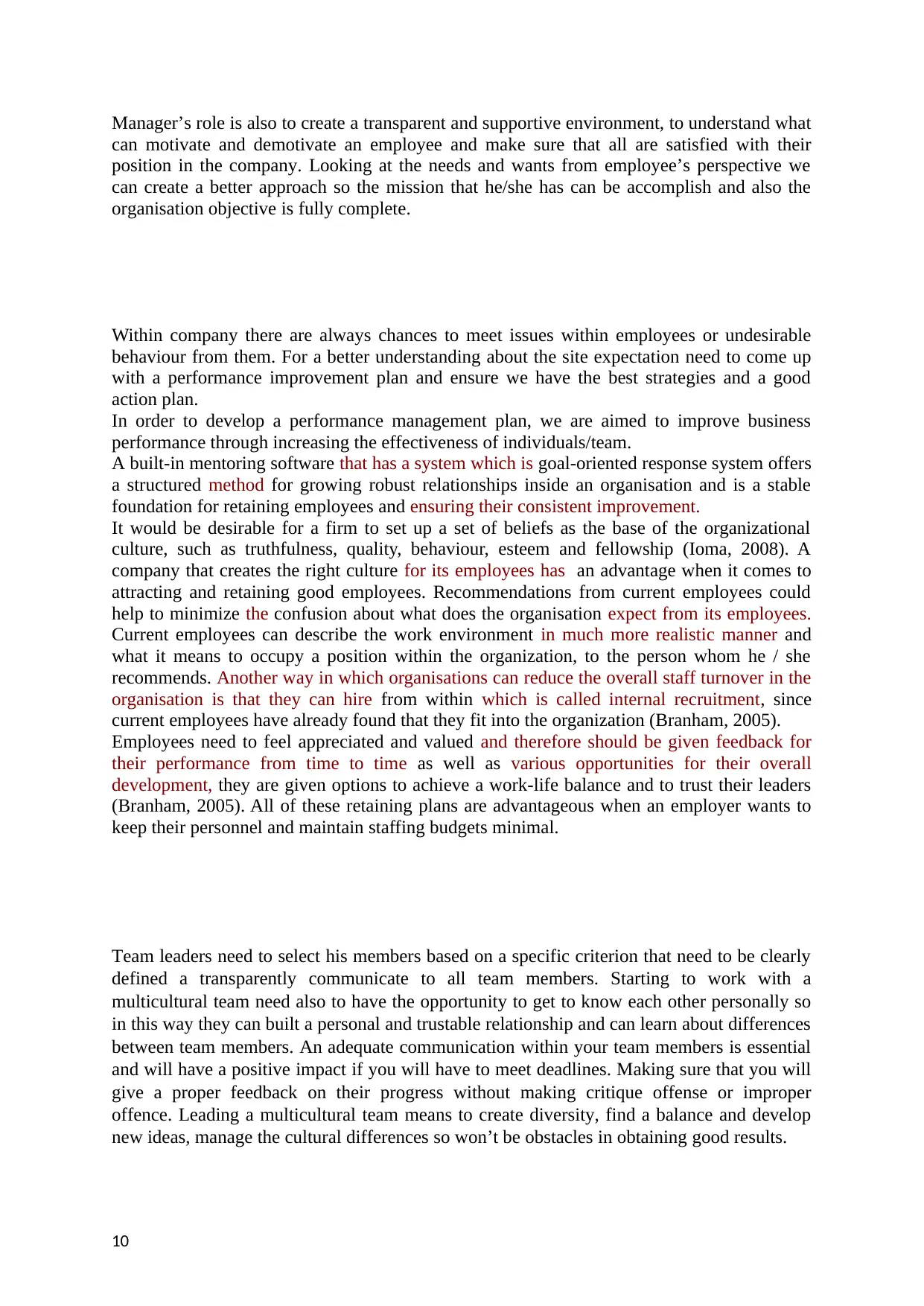
Manager’s role is also to create a transparent and supportive environment, to understand what
can motivate and demotivate an employee and make sure that all are satisfied with their
position in the company. Looking at the needs and wants from employee’s perspective we
can create a better approach so the mission that he/she has can be accomplish and also the
organisation objective is fully complete.
Within company there are always chances to meet issues within employees or undesirable
behaviour from them. For a better understanding about the site expectation need to come up
with a performance improvement plan and ensure we have the best strategies and a good
action plan.
In order to develop a performance management plan, we are aimed to improve business
performance through increasing the effectiveness of individuals/team.
A built-in mentoring software that has a system which is goal-oriented response system offers
a structured method for growing robust relationships inside an organisation and is a stable
foundation for retaining employees and ensuring their consistent improvement.
It would be desirable for a firm to set up a set of beliefs as the base of the organizational
culture, such as truthfulness, quality, behaviour, esteem and fellowship (Ioma, 2008). A
company that creates the right culture for its employees has an advantage when it comes to
attracting and retaining good employees. Recommendations from current employees could
help to minimize the confusion about what does the organisation expect from its employees.
Current employees can describe the work environment in much more realistic manner and
what it means to occupy a position within the organization, to the person whom he / she
recommends. Another way in which organisations can reduce the overall staff turnover in the
organisation is that they can hire from within which is called internal recruitment, since
current employees have already found that they fit into the organization (Branham, 2005).
Employees need to feel appreciated and valued and therefore should be given feedback for
their performance from time to time as well as various opportunities for their overall
development, they are given options to achieve a work-life balance and to trust their leaders
(Branham, 2005). All of these retaining plans are advantageous when an employer wants to
keep their personnel and maintain staffing budgets minimal.
Team leaders need to select his members based on a specific criterion that need to be clearly
defined a transparently communicate to all team members. Starting to work with a
multicultural team need also to have the opportunity to get to know each other personally so
in this way they can built a personal and trustable relationship and can learn about differences
between team members. An adequate communication within your team members is essential
and will have a positive impact if you will have to meet deadlines. Making sure that you will
give a proper feedback on their progress without making critique offense or improper
offence. Leading a multicultural team means to create diversity, find a balance and develop
new ideas, manage the cultural differences so won’t be obstacles in obtaining good results.
10
can motivate and demotivate an employee and make sure that all are satisfied with their
position in the company. Looking at the needs and wants from employee’s perspective we
can create a better approach so the mission that he/she has can be accomplish and also the
organisation objective is fully complete.
Within company there are always chances to meet issues within employees or undesirable
behaviour from them. For a better understanding about the site expectation need to come up
with a performance improvement plan and ensure we have the best strategies and a good
action plan.
In order to develop a performance management plan, we are aimed to improve business
performance through increasing the effectiveness of individuals/team.
A built-in mentoring software that has a system which is goal-oriented response system offers
a structured method for growing robust relationships inside an organisation and is a stable
foundation for retaining employees and ensuring their consistent improvement.
It would be desirable for a firm to set up a set of beliefs as the base of the organizational
culture, such as truthfulness, quality, behaviour, esteem and fellowship (Ioma, 2008). A
company that creates the right culture for its employees has an advantage when it comes to
attracting and retaining good employees. Recommendations from current employees could
help to minimize the confusion about what does the organisation expect from its employees.
Current employees can describe the work environment in much more realistic manner and
what it means to occupy a position within the organization, to the person whom he / she
recommends. Another way in which organisations can reduce the overall staff turnover in the
organisation is that they can hire from within which is called internal recruitment, since
current employees have already found that they fit into the organization (Branham, 2005).
Employees need to feel appreciated and valued and therefore should be given feedback for
their performance from time to time as well as various opportunities for their overall
development, they are given options to achieve a work-life balance and to trust their leaders
(Branham, 2005). All of these retaining plans are advantageous when an employer wants to
keep their personnel and maintain staffing budgets minimal.
Team leaders need to select his members based on a specific criterion that need to be clearly
defined a transparently communicate to all team members. Starting to work with a
multicultural team need also to have the opportunity to get to know each other personally so
in this way they can built a personal and trustable relationship and can learn about differences
between team members. An adequate communication within your team members is essential
and will have a positive impact if you will have to meet deadlines. Making sure that you will
give a proper feedback on their progress without making critique offense or improper
offence. Leading a multicultural team means to create diversity, find a balance and develop
new ideas, manage the cultural differences so won’t be obstacles in obtaining good results.
10
Secure Best Marks with AI Grader
Need help grading? Try our AI Grader for instant feedback on your assignments.
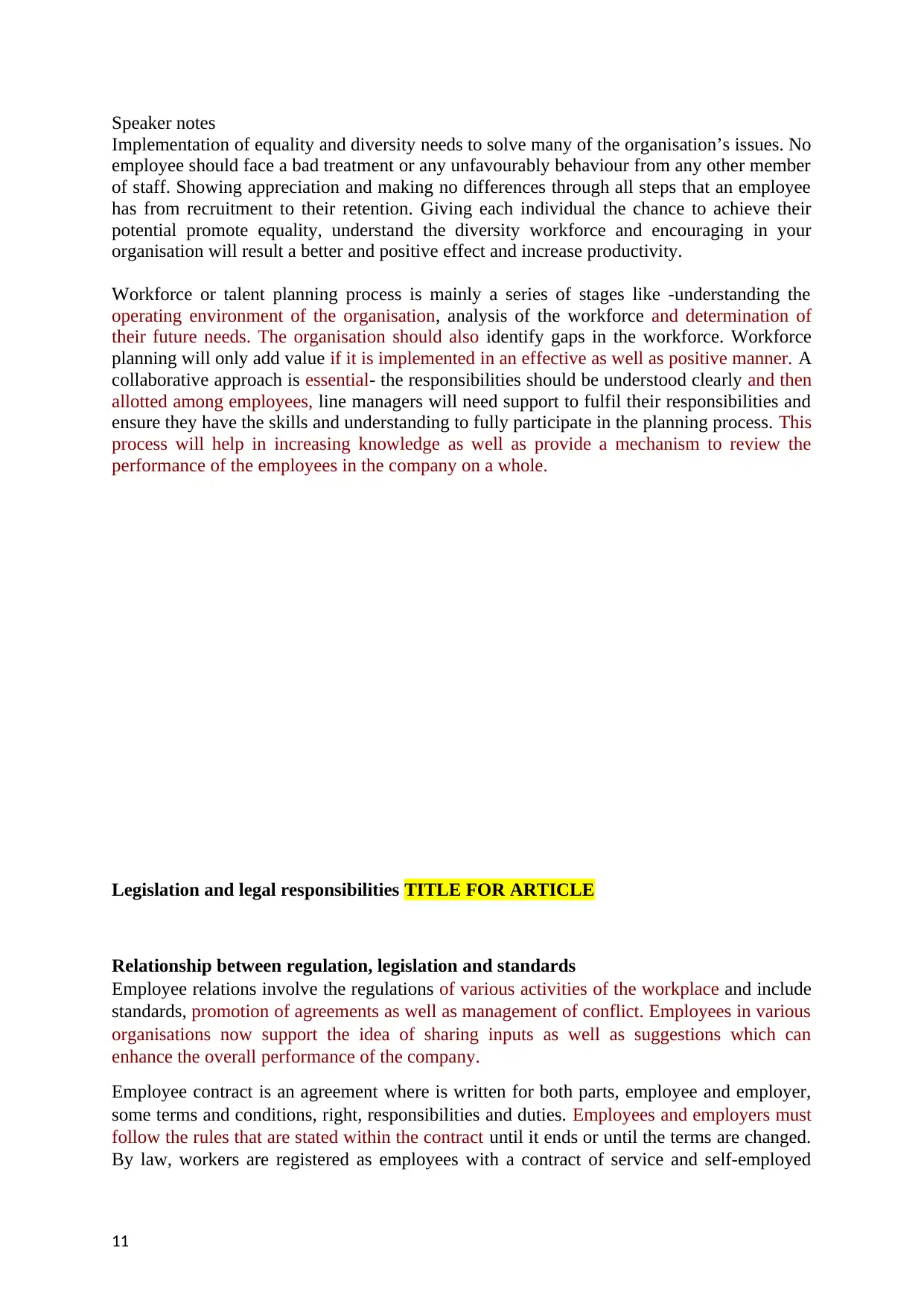
Speaker notes
Implementation of equality and diversity needs to solve many of the organisation’s issues. No
employee should face a bad treatment or any unfavourably behaviour from any other member
of staff. Showing appreciation and making no differences through all steps that an employee
has from recruitment to their retention. Giving each individual the chance to achieve their
potential promote equality, understand the diversity workforce and encouraging in your
organisation will result a better and positive effect and increase productivity.
Workforce or talent planning process is mainly a series of stages like -understanding the
operating environment of the organisation, analysis of the workforce and determination of
their future needs. The organisation should also identify gaps in the workforce. Workforce
planning will only add value if it is implemented in an effective as well as positive manner. A
collaborative approach is essential- the responsibilities should be understood clearly and then
allotted among employees, line managers will need support to fulfil their responsibilities and
ensure they have the skills and understanding to fully participate in the planning process. This
process will help in increasing knowledge as well as provide a mechanism to review the
performance of the employees in the company on a whole.
Legislation and legal responsibilities TITLE FOR ARTICLE
Relationship between regulation, legislation and standards
Employee relations involve the regulations of various activities of the workplace and include
standards, promotion of agreements as well as management of conflict. Employees in various
organisations now support the idea of sharing inputs as well as suggestions which can
enhance the overall performance of the company.
Employee contract is an agreement where is written for both parts, employee and employer,
some terms and conditions, right, responsibilities and duties. Employees and employers must
follow the rules that are stated within the contract until it ends or until the terms are changed.
By law, workers are registered as employees with a contract of service and self-employed
11
Implementation of equality and diversity needs to solve many of the organisation’s issues. No
employee should face a bad treatment or any unfavourably behaviour from any other member
of staff. Showing appreciation and making no differences through all steps that an employee
has from recruitment to their retention. Giving each individual the chance to achieve their
potential promote equality, understand the diversity workforce and encouraging in your
organisation will result a better and positive effect and increase productivity.
Workforce or talent planning process is mainly a series of stages like -understanding the
operating environment of the organisation, analysis of the workforce and determination of
their future needs. The organisation should also identify gaps in the workforce. Workforce
planning will only add value if it is implemented in an effective as well as positive manner. A
collaborative approach is essential- the responsibilities should be understood clearly and then
allotted among employees, line managers will need support to fulfil their responsibilities and
ensure they have the skills and understanding to fully participate in the planning process. This
process will help in increasing knowledge as well as provide a mechanism to review the
performance of the employees in the company on a whole.
Legislation and legal responsibilities TITLE FOR ARTICLE
Relationship between regulation, legislation and standards
Employee relations involve the regulations of various activities of the workplace and include
standards, promotion of agreements as well as management of conflict. Employees in various
organisations now support the idea of sharing inputs as well as suggestions which can
enhance the overall performance of the company.
Employee contract is an agreement where is written for both parts, employee and employer,
some terms and conditions, right, responsibilities and duties. Employees and employers must
follow the rules that are stated within the contract until it ends or until the terms are changed.
By law, workers are registered as employees with a contract of service and self-employed
11
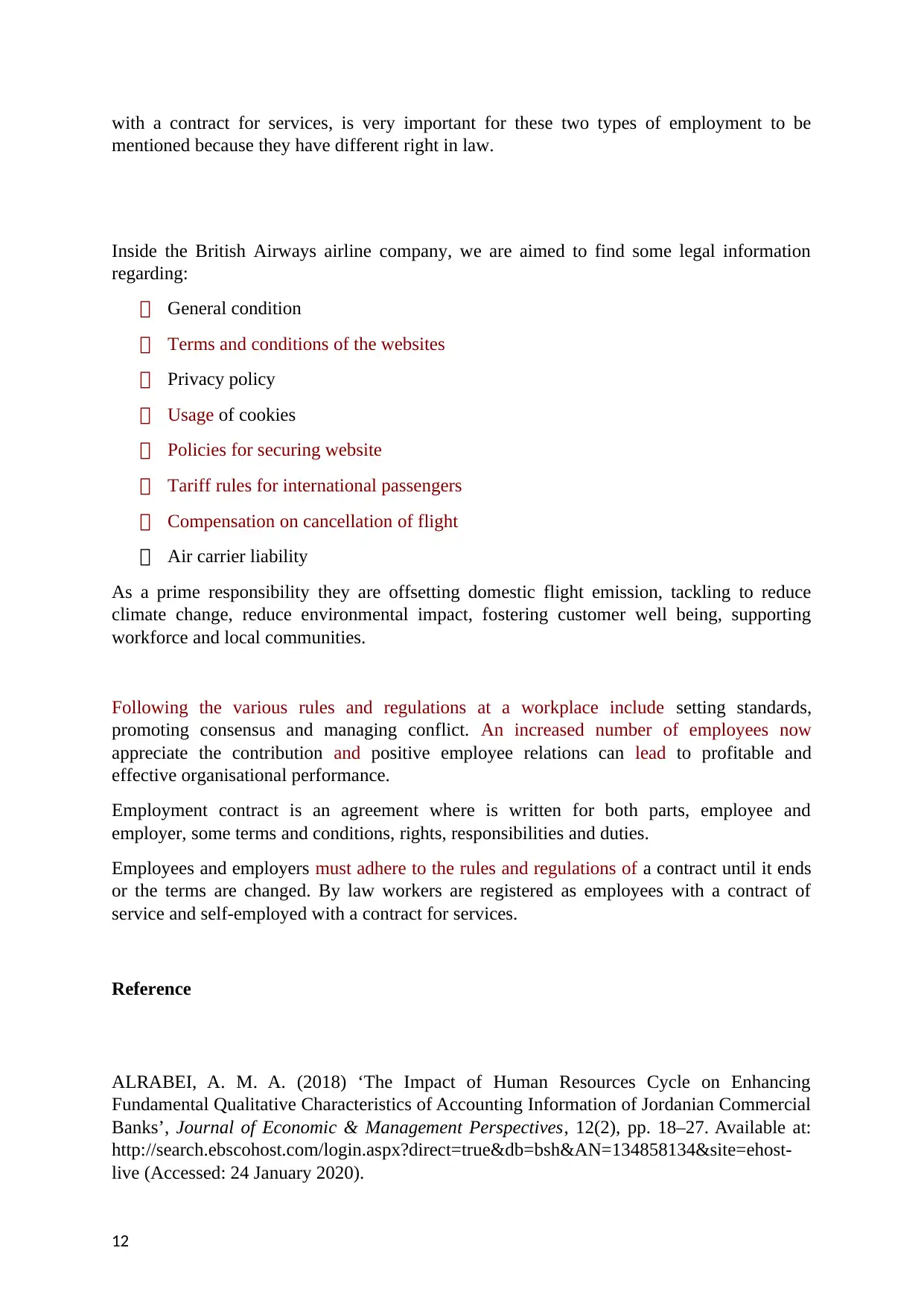
with a contract for services, is very important for these two types of employment to be
mentioned because they have different right in law.
Inside the British Airways airline company, we are aimed to find some legal information
regarding:
General condition
Terms and conditions of the websites
Privacy policy
Usage of cookies
Policies for securing website
Tariff rules for international passengers
Compensation on cancellation of flight
Air carrier liability
As a prime responsibility they are offsetting domestic flight emission, tackling to reduce
climate change, reduce environmental impact, fostering customer well being, supporting
workforce and local communities.
Following the various rules and regulations at a workplace include setting standards,
promoting consensus and managing conflict. An increased number of employees now
appreciate the contribution and positive employee relations can lead to profitable and
effective organisational performance.
Employment contract is an agreement where is written for both parts, employee and
employer, some terms and conditions, rights, responsibilities and duties.
Employees and employers must adhere to the rules and regulations of a contract until it ends
or the terms are changed. By law workers are registered as employees with a contract of
service and self-employed with a contract for services.
Reference
ALRABEI, A. M. A. (2018) ‘The Impact of Human Resources Cycle on Enhancing
Fundamental Qualitative Characteristics of Accounting Information of Jordanian Commercial
Banks’, Journal of Economic & Management Perspectives, 12(2), pp. 18–27. Available at:
http://search.ebscohost.com/login.aspx?direct=true&db=bsh&AN=134858134&site=ehost-
live (Accessed: 24 January 2020).
12
mentioned because they have different right in law.
Inside the British Airways airline company, we are aimed to find some legal information
regarding:
General condition
Terms and conditions of the websites
Privacy policy
Usage of cookies
Policies for securing website
Tariff rules for international passengers
Compensation on cancellation of flight
Air carrier liability
As a prime responsibility they are offsetting domestic flight emission, tackling to reduce
climate change, reduce environmental impact, fostering customer well being, supporting
workforce and local communities.
Following the various rules and regulations at a workplace include setting standards,
promoting consensus and managing conflict. An increased number of employees now
appreciate the contribution and positive employee relations can lead to profitable and
effective organisational performance.
Employment contract is an agreement where is written for both parts, employee and
employer, some terms and conditions, rights, responsibilities and duties.
Employees and employers must adhere to the rules and regulations of a contract until it ends
or the terms are changed. By law workers are registered as employees with a contract of
service and self-employed with a contract for services.
Reference
ALRABEI, A. M. A. (2018) ‘The Impact of Human Resources Cycle on Enhancing
Fundamental Qualitative Characteristics of Accounting Information of Jordanian Commercial
Banks’, Journal of Economic & Management Perspectives, 12(2), pp. 18–27. Available at:
http://search.ebscohost.com/login.aspx?direct=true&db=bsh&AN=134858134&site=ehost-
live (Accessed: 24 January 2020).
12
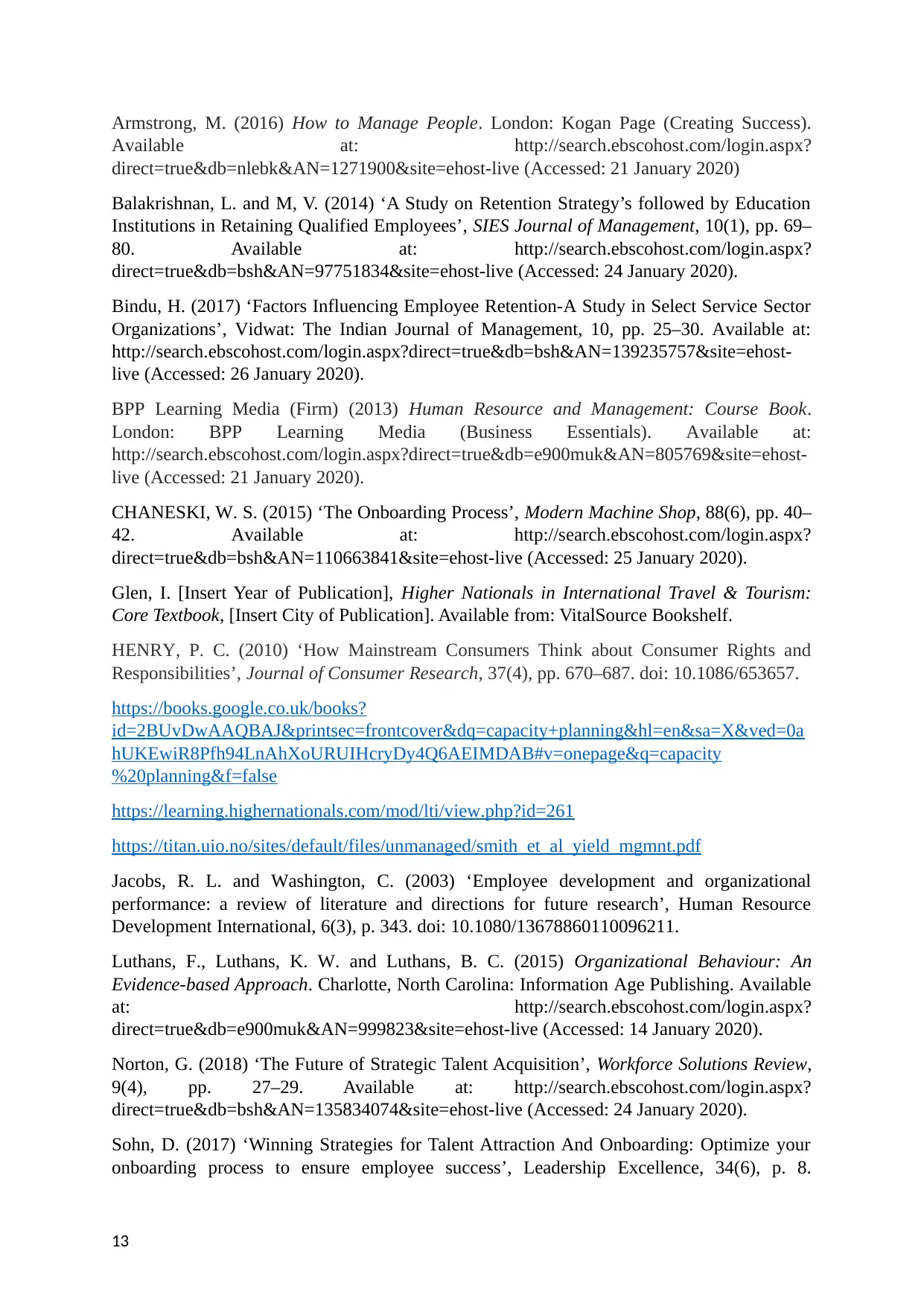
Armstrong, M. (2016) How to Manage People. London: Kogan Page (Creating Success).
Available at: http://search.ebscohost.com/login.aspx?
direct=true&db=nlebk&AN=1271900&site=ehost-live (Accessed: 21 January 2020)
Balakrishnan, L. and M, V. (2014) ‘A Study on Retention Strategy’s followed by Education
Institutions in Retaining Qualified Employees’, SIES Journal of Management, 10(1), pp. 69–
80. Available at: http://search.ebscohost.com/login.aspx?
direct=true&db=bsh&AN=97751834&site=ehost-live (Accessed: 24 January 2020).
Bindu, H. (2017) ‘Factors Influencing Employee Retention-A Study in Select Service Sector
Organizations’, Vidwat: The Indian Journal of Management, 10, pp. 25–30. Available at:
http://search.ebscohost.com/login.aspx?direct=true&db=bsh&AN=139235757&site=ehost-
live (Accessed: 26 January 2020).
BPP Learning Media (Firm) (2013) Human Resource and Management: Course Book.
London: BPP Learning Media (Business Essentials). Available at:
http://search.ebscohost.com/login.aspx?direct=true&db=e900muk&AN=805769&site=ehost-
live (Accessed: 21 January 2020).
CHANESKI, W. S. (2015) ‘The Onboarding Process’, Modern Machine Shop, 88(6), pp. 40–
42. Available at: http://search.ebscohost.com/login.aspx?
direct=true&db=bsh&AN=110663841&site=ehost-live (Accessed: 25 January 2020).
Glen, I. [Insert Year of Publication], Higher Nationals in International Travel & Tourism:
Core Textbook, [Insert City of Publication]. Available from: VitalSource Bookshelf.
HENRY, P. C. (2010) ‘How Mainstream Consumers Think about Consumer Rights and
Responsibilities’, Journal of Consumer Research, 37(4), pp. 670–687. doi: 10.1086/653657.
https://books.google.co.uk/books?
id=2BUvDwAAQBAJ&printsec=frontcover&dq=capacity+planning&hl=en&sa=X&ved=0a
hUKEwiR8Pfh94LnAhXoURUIHcryDy4Q6AEIMDAB#v=onepage&q=capacity
%20planning&f=false
https://learning.highernationals.com/mod/lti/view.php?id=261
https://titan.uio.no/sites/default/files/unmanaged/smith_et_al_yield_mgmnt.pdf
Jacobs, R. L. and Washington, C. (2003) ‘Employee development and organizational
performance: a review of literature and directions for future research’, Human Resource
Development International, 6(3), p. 343. doi: 10.1080/13678860110096211.
Luthans, F., Luthans, K. W. and Luthans, B. C. (2015) Organizational Behaviour: An
Evidence-based Approach. Charlotte, North Carolina: Information Age Publishing. Available
at: http://search.ebscohost.com/login.aspx?
direct=true&db=e900muk&AN=999823&site=ehost-live (Accessed: 14 January 2020).
Norton, G. (2018) ‘The Future of Strategic Talent Acquisition’, Workforce Solutions Review,
9(4), pp. 27–29. Available at: http://search.ebscohost.com/login.aspx?
direct=true&db=bsh&AN=135834074&site=ehost-live (Accessed: 24 January 2020).
Sohn, D. (2017) ‘Winning Strategies for Talent Attraction And Onboarding: Optimize your
onboarding process to ensure employee success’, Leadership Excellence, 34(6), p. 8.
13
Available at: http://search.ebscohost.com/login.aspx?
direct=true&db=nlebk&AN=1271900&site=ehost-live (Accessed: 21 January 2020)
Balakrishnan, L. and M, V. (2014) ‘A Study on Retention Strategy’s followed by Education
Institutions in Retaining Qualified Employees’, SIES Journal of Management, 10(1), pp. 69–
80. Available at: http://search.ebscohost.com/login.aspx?
direct=true&db=bsh&AN=97751834&site=ehost-live (Accessed: 24 January 2020).
Bindu, H. (2017) ‘Factors Influencing Employee Retention-A Study in Select Service Sector
Organizations’, Vidwat: The Indian Journal of Management, 10, pp. 25–30. Available at:
http://search.ebscohost.com/login.aspx?direct=true&db=bsh&AN=139235757&site=ehost-
live (Accessed: 26 January 2020).
BPP Learning Media (Firm) (2013) Human Resource and Management: Course Book.
London: BPP Learning Media (Business Essentials). Available at:
http://search.ebscohost.com/login.aspx?direct=true&db=e900muk&AN=805769&site=ehost-
live (Accessed: 21 January 2020).
CHANESKI, W. S. (2015) ‘The Onboarding Process’, Modern Machine Shop, 88(6), pp. 40–
42. Available at: http://search.ebscohost.com/login.aspx?
direct=true&db=bsh&AN=110663841&site=ehost-live (Accessed: 25 January 2020).
Glen, I. [Insert Year of Publication], Higher Nationals in International Travel & Tourism:
Core Textbook, [Insert City of Publication]. Available from: VitalSource Bookshelf.
HENRY, P. C. (2010) ‘How Mainstream Consumers Think about Consumer Rights and
Responsibilities’, Journal of Consumer Research, 37(4), pp. 670–687. doi: 10.1086/653657.
https://books.google.co.uk/books?
id=2BUvDwAAQBAJ&printsec=frontcover&dq=capacity+planning&hl=en&sa=X&ved=0a
hUKEwiR8Pfh94LnAhXoURUIHcryDy4Q6AEIMDAB#v=onepage&q=capacity
%20planning&f=false
https://learning.highernationals.com/mod/lti/view.php?id=261
https://titan.uio.no/sites/default/files/unmanaged/smith_et_al_yield_mgmnt.pdf
Jacobs, R. L. and Washington, C. (2003) ‘Employee development and organizational
performance: a review of literature and directions for future research’, Human Resource
Development International, 6(3), p. 343. doi: 10.1080/13678860110096211.
Luthans, F., Luthans, K. W. and Luthans, B. C. (2015) Organizational Behaviour: An
Evidence-based Approach. Charlotte, North Carolina: Information Age Publishing. Available
at: http://search.ebscohost.com/login.aspx?
direct=true&db=e900muk&AN=999823&site=ehost-live (Accessed: 14 January 2020).
Norton, G. (2018) ‘The Future of Strategic Talent Acquisition’, Workforce Solutions Review,
9(4), pp. 27–29. Available at: http://search.ebscohost.com/login.aspx?
direct=true&db=bsh&AN=135834074&site=ehost-live (Accessed: 24 January 2020).
Sohn, D. (2017) ‘Winning Strategies for Talent Attraction And Onboarding: Optimize your
onboarding process to ensure employee success’, Leadership Excellence, 34(6), p. 8.
13
Paraphrase This Document
Need a fresh take? Get an instant paraphrase of this document with our AI Paraphraser
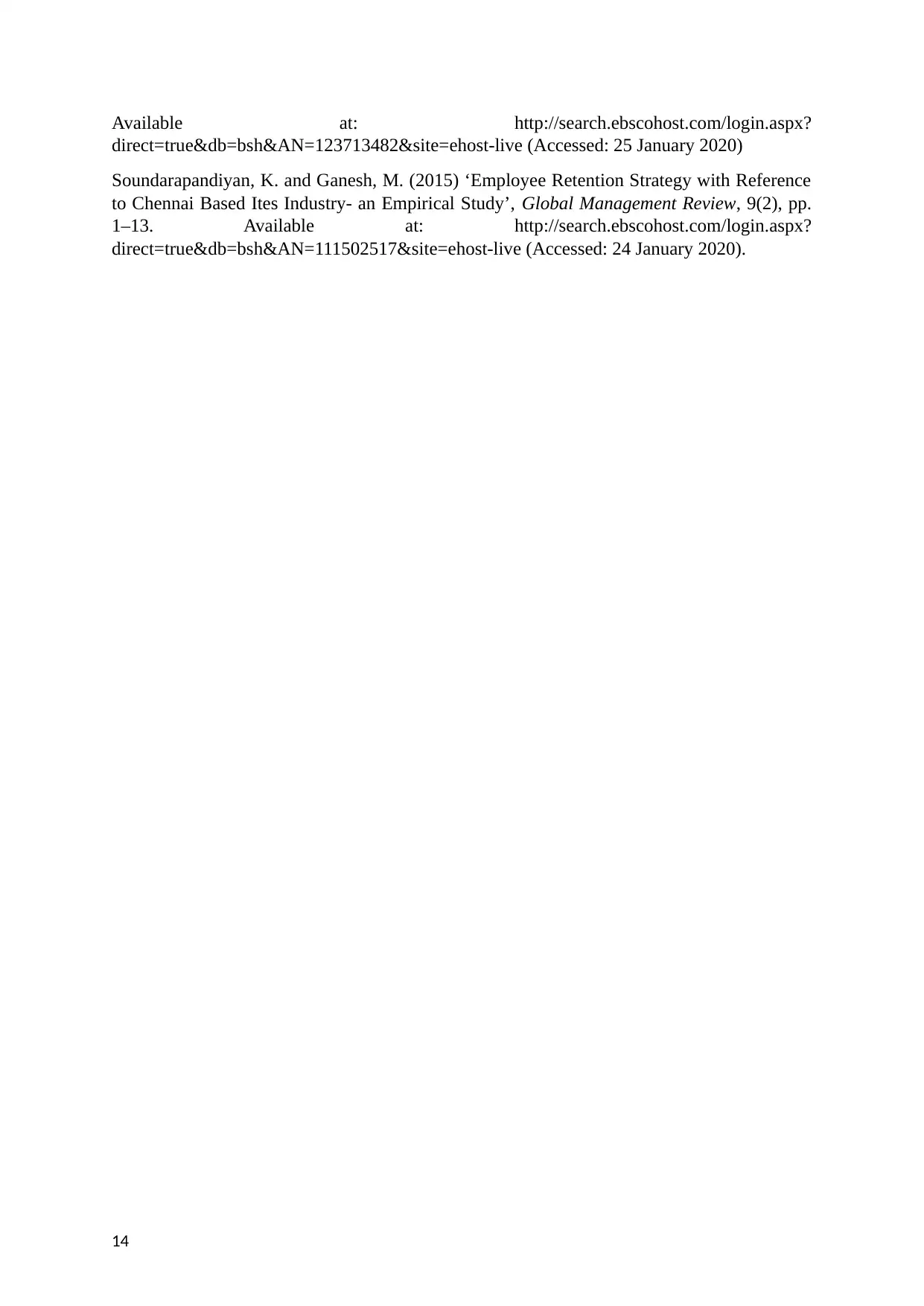
Available at: http://search.ebscohost.com/login.aspx?
direct=true&db=bsh&AN=123713482&site=ehost-live (Accessed: 25 January 2020)
Soundarapandiyan, K. and Ganesh, M. (2015) ‘Employee Retention Strategy with Reference
to Chennai Based Ites Industry- an Empirical Study’, Global Management Review, 9(2), pp.
1–13. Available at: http://search.ebscohost.com/login.aspx?
direct=true&db=bsh&AN=111502517&site=ehost-live (Accessed: 24 January 2020).
14
direct=true&db=bsh&AN=123713482&site=ehost-live (Accessed: 25 January 2020)
Soundarapandiyan, K. and Ganesh, M. (2015) ‘Employee Retention Strategy with Reference
to Chennai Based Ites Industry- an Empirical Study’, Global Management Review, 9(2), pp.
1–13. Available at: http://search.ebscohost.com/login.aspx?
direct=true&db=bsh&AN=111502517&site=ehost-live (Accessed: 24 January 2020).
14
1 out of 14
Related Documents
Your All-in-One AI-Powered Toolkit for Academic Success.
+13062052269
info@desklib.com
Available 24*7 on WhatsApp / Email
![[object Object]](/_next/static/media/star-bottom.7253800d.svg)
Unlock your academic potential
© 2024 | Zucol Services PVT LTD | All rights reserved.





